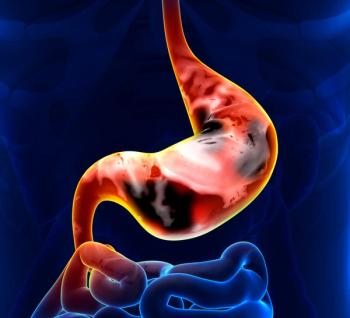
Oncology NEWS International
- Oncology NEWS International Vol 10 No 9
- Volume 10
- Issue 9
Integrating COX-2 Inhibition with Chemoradiation for Rectal Cancer
HOUSTON-M. D. Anderson Cancer Center researchers have launched a phase I trial combining pelvic radiation, irinotecan (Camptosar), and celecoxib (Celebrex) in patients with metastatic rectal cancer. Christopher H. Crane, MD, assistant professor of radiation oncology at the University of Texas M. D. Anderson Cancer Center described the research leading up to this trial
HOUSTONM. D. Anderson Cancer Center researchers have launched a phase I trial combining pelvic radiation, irinotecan (Camptosar), and celecoxib (Celebrex) in patients with metastatic rectal cancer. Christopher H. Crane, MD, assistant professor of radiation oncology at the University of Texas M. D. Anderson Cancer Center described the research leading up to this trial.
"Over the past 10 years we have treated patients with a program of neoadjuvant chemoradiation with infusional 5-fluorouracil (5-FU), and we now have nearly 400 patients who have been treated with a curative resection. Patients who have a complete response to chemoradiation have improved local control, improved survival, and sphincter preservation. We also have some intriguing data suggesting that organ preserving is possible in selected patients, and our interest in the potential benefits of adding cyclooxygenase-2 (COX-2) inhibition to the regimen is the hope that it will increase the number of such patients," Dr. Crane, said.
Dr. Crane reported that both univariate and multivariate analyses of these patients showed that those who had either a pathologic complete response or only microscopic residual disease had significantly better local control and overall survival.
Presents Difficult Problem
Low rectal cancer is a difficult problem because patients are concerned about the potential need for colostomy. "When we stratified patients by the distance of the tumor from the anal verge, and stratified them by whether they had a complete response or an incomplete response, we found that patients who had tumors in the very low rectum had a statistically significant improvement in sphincter preservation. Response was independently significant for sphincter preservation," Dr. Crane said.
Over the past decade the M. D. Anderson researchers have also treated 15 of 181 patients with T3 rectal tumors who had clinical complete response following chemoradiation and then had full-thickness local excision.
"Local excision in T-3 patients is generally discouraged because of high local recurrence rates, even with postoperative chemoradiation. Our cases were mostly patients who refused radical surgery or were medically inoperable. In this population of complete responders, we have had one pelvic nodal recurrence, which occurred in a patient who in retrospect had imaging evidence of a node in the pelvis. We have also had had one inguinal failure in a very low lesion. The follow-up is a median 40 months (range 8 to 96), which is not long enough to conclude anything, but this is certainly provocative data," Dr. Crane said. This raises the intriguing possibility that patients with complete responses might be managed nonsurgically or with local excision.
Possible molecular targets for increasing the number of complete responders include epidermal growth factor receptors (EGFR) inhibitors, kinase inhibitors, farnesyl transferase inhibitors, angiogenesis inhibitors, proteasome inhibitors, COX-2 inhibitors, and apoptosis inducers. Dr. Crane’s group has done preclinical work with COX-2 inhibitors.
COX-2 Is Overexpressed
Dr. Crane said that COX-2 is overexpressed in the epithelium of malignant tumors. The vasculature of malignant tumors can be blocked with the COX-2 selective inhibitor and is not upregulated in normal colonic mucosa. COX-2 has been implicated in carcinogenesis, tumor cell proliferation, tumor angiogenesis, invasion and metastasis, poor prognosis, and possibly resistance to therapy. The rationale for the use of COX-2 inhibitors in radiotherapy is that prostaglandins act as radioprotectors of normal tissues. Indomethacin, a nonselective COX inhibitor, reduced the TCD-50 dose of radiation needed to cure tumors in mice.
"In summary, COX-2 inhibitors exert independent activity in preclinical models. They enhance tumor radio-response. They enhance tumor chemo-response. They do not affect normal tissue radio-response, and they act by multiple mechanisms. Possible mechanisms include increased intrinsic radiosensitivity, cell-cycle redistribution, induction of apoptosis, inhibition of growth factor regulation, anti-angiogenesis, and immunostimulation," Dr. Crane said.
"Preclinical data suggest that COX-2 inhibition produces selective radiosensitization. Increasing response in rectal cancer could improve pelvic control and survival, may even lead to organ preservation," Dr. Crane said.
To test this possibility, M. D. Anderson researchers have opened a phase I trial for patients with metastatic rectal cancer. This study will combine pelvic radiation, celecoxib, and irinotecan, Dr. Crane said that the investigators will give 45 Gy of radiation, escalate the irinotecan dose beginning at 30 mg/m², and escalate the celecoxib dose starting at 200 mg/m².
Articles in this issue
over 24 years ago
Avon Launches ‘Kiss Goodbye to Breast Cancer’ Campaignover 24 years ago
Occult Tumor Cells in Marrow Predict Breast Cancer Survivalover 24 years ago
No Long-Term Advantage for Complete Response to Neoadjuvant Chemo/RTover 24 years ago
New Agents Tested with 5-FU in Rectal Cancerover 24 years ago
Anticonvulsants Can Alter Irinotecan Metabolismover 24 years ago
Thalidomide Appears Effective in Early-Stage Myelomaover 24 years ago
New ‘Goals for Pain Relief’ Scale Proves Reliable in Pilot Studyover 24 years ago
GVAX Autologous Vaccine Shows Activity in Lung CancerNewsletter
Stay up to date on recent advances in the multidisciplinary approach to cancer.
















































































